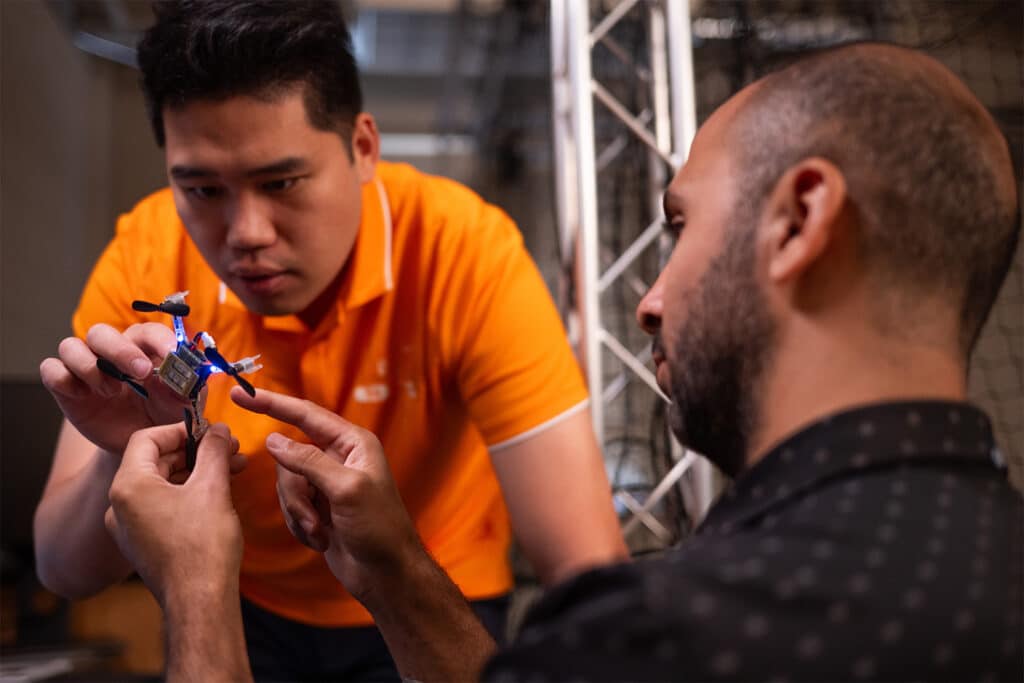
Aerospace Engineering, MS
Aerospace engineering is a rapidly evolving field, with continuous technological advancements leading to important space exploration and scientific discoveries, better national security, increased reliability in air transportation, and more. As a grad student in UT’s aerospace engineering program, you will gain the expertise and real-world research experience needed to make meaningful contributions in a field of study that is pushing the boundaries of what we think we know to be possible.
Program overview
Pursuing an MS in chemical engineering provides a deeper knowledge of fundamental concepts in the field, as well as an additional focus on theoretical understanding. The proximity of UT to several companies of interest and our faculty’s high-impact research are major pulls for many of our students. If you’re thinking about a career in the process engineering industry, this program may be a great fit for you.
- Hypersonics
- Aerodynamics
- Computational fluid dynamics
- Fluid mechanics
- Mission planning
- Propulsion
- Orbital mechanics
- Stability and control
Concentrations
Students pursuing their graduate degree in aerospace engineering have several concentrations to choose from including:
- Applied Mechanics
- Nuclear Space Science and Engineering
- Systems and Controls
- Thermal-Fluid Mechanics
- MS-MBA Program
Why Study Aerospace Engineering at UT?
The University of Tennessee, Knoxville, offers several unique opportunities for students who wish to pursue a graduate degree in aerospace engineering, including research partnerships with both government and industry partners. Our world-renowned faculty are experts in fields like hypersonics, aerodynamics, fluid mechanics, mission planning, and more. Their research is conducted at our main campus in Knoxville but also at the University of Tennessee Space Institute in Tullahoma.
Nationally Recognized Leadership in Education and Research
Our aerospace engineering program is nationally recognized for its research. Our on-campus partnerships include access to world-class facilities and resources like our Tennessee Aerothermodynamics Laboratory, the NASA Ice Contamination Effects Flight Training Device, the UT Space Institute, and other labs and centers for hands-on research experiences.
Research Assistantship Opportunities
Graduate Research Assistantships (GRAs) are offered directly though faculty members, offering students support while they perform research, including benefits like tuition reimbursement, a monthly stipend, and health insurance.
What can you do with a MS in Aerospace Engineering after graduation?
Aerospace engineers are involved in the design, development, testing and production of aircraft, spacecraft, and related systems and equipment. They can work to design and improve missile systems for national security, develop satellites to monitor environments for emergency and disaster management, or drive development of new markets like space tourism for economic growth. With an MS in aerospace engineering, you can pursue more advanced careers, such as working as a consultant, aerospace project manager, or continuing your education in academia as a professor or scientist.
UT Alumni
Our program is proud to boast the success of our alumni who have gone on to be employed by NASA, Pratt and Whitney, and SpaceX, with nine NASA astronauts in our alumni ranks who have spent a collective of 1,000+ days in space.
Featured Courses
Below are some of the courses that students in our program can choose to take. For a full list of courses, visit the Graduate Catalog.
AE 513 Experimental Methods in Fluid Mechanics
Experimental methodology and techniques emphasizing measurements in high-speed flows; wind tunnel facilities; data acquisition principles; modern optical and laser diagnostics.
AE 515 Air Vehicle Aerodynamics and Performance
Application of aerodynamics principles to air vehicles to provide estimates of performance, stability, and control characteristics for subsonic to hypersonic speeds. Relations among thrust, drag, lift and attitude, propulsion systems, vehicle performance characteristics, and trajectory optimization.
AE 532 Introduction to Turbulence
Macroscopic effects, analogies, statistical treatment, correlation functions, energy spectra, diffusion; application of turbulent jets and pipe flow.
AE 544 Engineering Laser Spectroscopy
Covers state-of-the-art topics involving laser spectroscopy for engineering applications. It will include, but not limit to, fundamental optics, electromagnetic wave, principle of laser, laser induced fluorescence, laser scattering, Rayleigh scattering, Raman scattering, nonlinear optical spectroscopy and novel nanophotonics.
Related Programs
Check out a list of related programs to look into based on your interest in aerospace engineering:
Admissions and Aid
Choosing the right university to pursue an engineering degree is an important decision—and a significant investment. We want to make sure that you have the information you need to both apply and make attending UT affordable.


Ready to Join Us?
See yourself on Rocky Top? We’ve made it easier than ever to apply for admission. Learn more about our admission requirements and the steps to apply to be an Engineering Vol.
